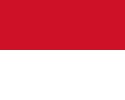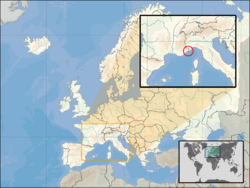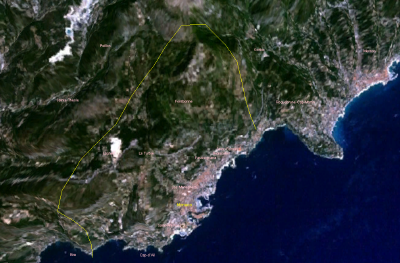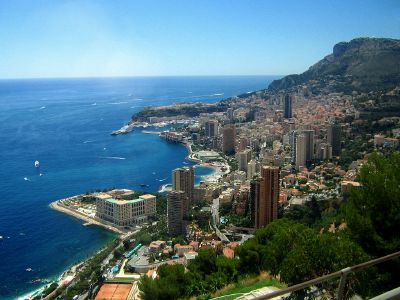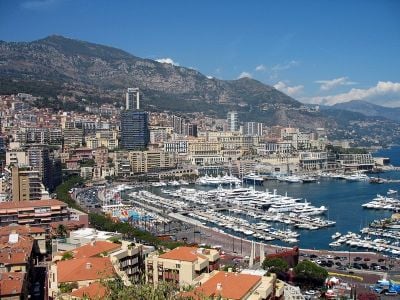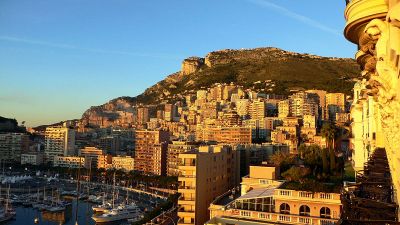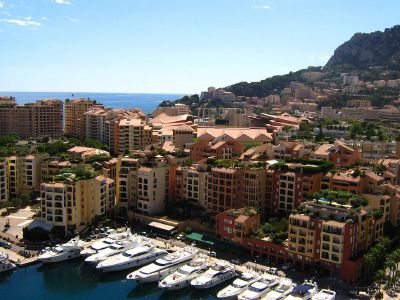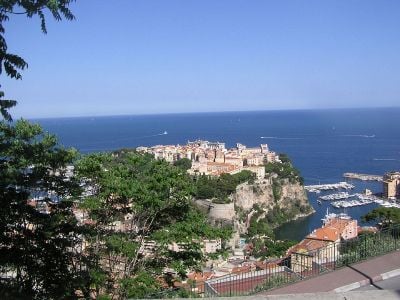Monaco
| Principatu de M√ļnegu (Mon√©gasque) Principaut√© de Monaco (French) Principality of Monaco |
||||||
|---|---|---|---|---|---|---|
|
||||||
| Motto: "Deo Juvante" (Latin) "With God's Help" |
||||||
| Anthem: Hymne Monégasque |
||||||
| |
||||||
| Capital | Monaco[1] | |||||
| Largest Most populated quartier | Monte Carlo |
|||||
| Official languages | French[1] | |||||
| Common languages | Monégasque, Italian, and English | |||||
| Demonym | Monégasque or Monegasque | |||||
| Government | Unitary principality Constitutional monarchy | |||||
|  -  | Prince | Albert II | ||||
|  -  | Minister of State | Pierre Dartout | ||||
| Independence | ||||||
|  -  | House of Grimaldi | 1297  | ||||
|  -  | Constitution | 1911  | ||||
| Area | ||||||
|  -  | Total | 1.98 km² (234th) 0.76 sq mi  |
||||
|  -  | Water (%) | 0.0[1] | ||||
| Population | ||||||
|  -  | 2023 estimate | 31,597 [1]  | ||||
|  -  | 2016 census | 37,308[2]  | ||||
|  -  | Density | 18,774/km² (1st) 48,462/sq mi |
||||
| GDP (PPP) | 2015 estimate | |||||
|  -  | Total | |||||
|  -  | Per capita | |||||
| GDP (nominal) | 2019[b] estimate | |||||
|  -  | Total | |||||
|  -  | Per capita | |||||
| Currency | Euro (EUR) |
|||||
| Time zone | CET (UTC+1) | |||||
|  -  | Summer (DST) | CEST (UTC+2) | ||||
| Internet TLD | .mc | |||||
| Calling code | [[++377]] | |||||
| 1 | Monaco is a city-state. | |||||
| 2 | GDP per capita calculations include non-resident workers from France and Italy. | |||||
The Principality of Monaco, more commonly known as Monaco, is a sovereign and independent state in Western Europe located along the French Riviera between the Mediterranean Sea and France. It is one of six microstates located in Europe and the smallest French-speaking sovereignty.
Monaco is the world's most densely populated state and second-smallest independent state, only behind Vatican City. It has a population of 32,410 in a total land area of only 0.75 square miles (485 acres) and is almost entirely urban.
Founded in 1215 as a colony of Genoa, Monaco has been ruled by the House of Grimaldi since 1297. A principality was established in 1338. It has remained under Grimaldi control except for a brief period (1793 - 1814) under French control. Designated as a protectorate of Sardinia from 1815 until 1860 by the Treaty of Vienna, Monaco's sovereignty was recognized by the Franco-Monegasque Treaty of 1861. The Prince of Monaco was an absolute ruler until a constitution was promulgated in 1911.
Monaco is known for its highly rated and famous casino, Monte Carlo, its beautiful Mediterranean outlook and the popular Grace Kelly, an Academy Award-winning Hollywood actress who married Prince Rainier and became Princess Grace of Monaco.
Geography
With a total area of 0.75 square miles, a land border of 2.7 miles, and a coast measuring 2.5 miles, the Principality of Monaco is the second-smallest independent state in the world, after the Vatican City. It lies on the coast of the Mediterranean Sea, 11 miles east of Nice, France, and is surrounded on three sides by France and on the fourth by the sea into which its maritime claims extend to 13.8 miles. Its highest point is 535 ft. above sea level, on the southern slopes of 'Mont Agel' whose 3,638 ft. peak is in France. There are no natural resources to the country.
Monaco is divided into four sections: Monaco-Ville, the old city on a rocky promontory extending into the Mediterranean; La Condamine, the section along the port; Monte Carlo, the principal residential and resort area; and Fontvieille, a newly constructed area reclaimed from the sea.
The principality‚ÄĒentirely an urban area‚ÄĒis noted for its beautiful, hilly, rugged, and rocky natural scenery and its sunny Mediterranean climate with mild, wet winters and hot, dry summers moderated by the proximity of the Mediterranean Sea. The average minimum temperature in January and February is 46 ¬ļF., and in July and August the average maximum temperature is 79 ¬ļF.
History
The early history of Monaco was primarily concerned with the protective and strategic value of the Rock of Monaco, the area's chief geological landmark, which served first as a shelter for ancient peoples and later as a fortress. From the 1200s to the early 1400s, the area was contested for primarily political reasons; since that point, excepting a period of French occupation, it has remained steadily under the control of the House of Grimaldi.
Early history and Ligurian settlement
The Rock of Monaco served as a shelter for the area's early inhabitants from the end of the Paleolithic period, approximately 300,000 B.C.E., evidence of which has been found in a cave in St. Martin's Gardens. According to the accounts of historian Diodorus Siculus and geographer Strabo, the area's first permanent settlers were the mountain-dwelling Ligures, who emigrated from their native city of Genoa, Italy. However, the ancient Ligurian language, which was apparently not Indo-European, is not connected to the Italian dialect spoken by the modern inhabitants of Liguria, nor to the modern Monegasque language.
Greek colonization and Herculean legend
The Phocaeans of Massalia founded the colony of Monoikos, named for its Ligurian inhabitants, in the sixth century B.C.E. in the area now known as Monaco. Monoikos was associated with Hercules, venerated in this location alone as Hercules Monoecus. According to the "travels of Hercules" theme, also documented by Diodorus Siculus and Strabo, both Greeks and native Ligurian people asserted that Hercules passed through the area.
The modern port is still sometimes called the "Port of Hercules." The 1907 Catholic Encyclopedia wrote, "From ancient times until the nineteenth century the port of Monaco was among the most important of the French Mediterranean coast, but now it has lost all commercial significance."
Roman rule
After the Gallic Wars, Monoecus, which served as a stopping-point for Julius Caesar on his way to campaign in Greece, fell under Roman control as part of the Maritime Alps province (Gallia Transalpina).
The Roman poet Virgil called it "that castled cliff, Monoecus by the sea" (Aeneid, VI.830). The commentator Servius's use of the passage (in R. Maltby, Lexicon of Ancient Latin Etymologies, Leeds) asserts, under the entry portus, that the epithet was derived:
- dictus autem Monoecus vel quod pulsis omnibus illic solus habitavit ("either because Hercules drove off everyone else and lived there alone"), vel quod in eius templo numquam aliquis deorum simul colitur ("or because in his temple no other of the gods is worshipped at the same time"). (No actual temple to Hercules has been located at Monaco).
The port is mentioned in Pliny the Elder's Natural History (III.v) and in Tacitus' Histories (III.42), when Valens was forced to pull into the port.
Middle Ages
Monaco remained under Roman control until the collapse of the Western Roman Empire in 476, from which point the area was ravaged by Saracens and various barbarian tribes. Though these raids left the area almost entirely depopulated, the Saracens were expelled in 975, and by the eleventh century the area was again populated by Ligurians.
In 1191, Holy Roman Emperor Henry VI granted suzerainty over the area to the city of Genoa, the native home of the Ligurians. On June 10, 1215, a detachment of Genoese Ghibellines led by Fulco del Cassello began the construction of a fortress atop the Rock of Monaco. This date is often cited as the beginning of Monaco's modern history.
As the Ghibellines intended their fortress to be a strategic military stronghold and center of control for the area, they set about creating a settlement around the base of the Rock to support the garrison; in an attempt to lure residents from Genoa and the surrounding cities, they offered land grants and tax exemption to new settlers.
Rise of the Grimaldis
The Grimaldis, descended from Otto Canella and taking their name from his son Grimaldo, were an ancient and prominent Guelphic Genoese family who, in the course of the civil strife in Genoa between the Guelphs and Ghibellines, took refuge in Monaco, accompanied by various other Guelphic families, most notably the Fieschis.
François Grimaldi seized the Rock of Monaco in 1297; the area remains under the control of the Grimaldi family to the present day, except when it fell under French control from 1793 to May 17, 1814. Designated as a protectorate of the Kingdom of Sardinia in 1815 by the Congress of Vienna after Napoleon's defeat, Monaco's sovereignty was confirmed by the Franco-Monegasque Treaty of 1861. The Prince of Monaco was an absolute ruler until a constitution was promulgated in 1911.
The famous Casino of Monte Carlo opened in 1863, organized by the Societé des Bains de Mer ("Sea-bathing Society"), which also ran the Hotel de Paris; taxes paid by the Sea-bathing Society have supported Monaco's infrastructure. Economic development was spurred in the late 19th century with a railroad link to France. In July 1918, a treaty was signed providing for limited French protection over Monaco. The treaty, written into the Treaty of Versailles, established that Monegasque policy would be aligned with French political, military, and economic interests. One of the motivations for the treaty was the anticipated upcoming Monaco Succession Crisis of 1918.
While Prince Louis II' sympathies were strongly pro-French, he tried to keep Monaco neutral during World War II but supported the Vichy French government of his old army colleague, Marshall Philippe Pétain. Nonetheless, his tiny principality was tormented by domestic conflict partly as a result of Louis' indecisiveness, and also because the majority of the population was of Italian descent; many of them supported the fascist regime of Italy's Benito Mussolini. In 1943, the Italian Army invaded and occupied Monaco, setting up a fascist puppet government. Soon after, following Mussolini's fall in Italy, the German Army occupied Monaco and began the deportation of the Jewish population. Among them was René Blum, founder of the Opera, who died in a Nazi concentration camp. Under Prince Louis' secret orders, the Monaco police, often at great risk to themselves, warned people in advance that the Gestapo was planning on arresting them. The country was liberated as German troops retreated.
Present day
Prince Albert II succeeded his father Prince Rainier III in 2005. Prince Rainier, in turn, had acceded to the throne following the death of his grandfather, Prince Louis II, in 1949.
The revised Constitution of Monaco, proclaimed in 1962, abolished capital punishment, provided for female suffrage, established a Supreme Court to guarantee fundamental liberties and made it difficult for a French national to transfer his or her residence there.
In 2002, a new treaty between France and Monaco clarifies that if there are no heirs to carry on the dynasty, the Principality will remain an independent nation, rather than be annexed by France. Monaco's military defense, however, is still the responsibility of France.
Law and government
Monaco has been governed as a constitutional monarchy since 1911, with the Sovereign Prince of Monaco as head of state. The executive branch consists of a Minister of State (the head of government), who presides over a four-member Council of Government (the Cabinet). The minister of state is a French citizen appointed by the prince from among candidates proposed by the French government. Under the 1962 constitution, the prince shares his power with the unicameral National Council (parliament). The twenty-four members of this legislative body are elected from lists by universal suffrage for five-year terms. The principality's local affairs are directed by the Communal Council, which consists of fifteen elected members and is presided over by the mayor
Monaco became a member of the United Nations in 1991, and received its first foreign diplomatic representative on February 16th, 2006, when a French Ambassador was accredited to the Principality.
On both a per-capita and per-area basis, Monaco has the largest police force and police presence in the world.
The Compagnie des Carabiniers du Prince (Prince's Company of Carabiniers) is the military force of Monaco. Although Monaco's defense is the responsibility of France, it maintains a small force for the protection of the Sovereign Prince of Monaco. It was formed by Prince Honoré IV in 1817 for the protection of the Principality. The company numbers approximately one hundred officers and men; while the non-commissioned officer (NCOs) and soldiers are local, the officers have generally served in the French Army. Together with the local fire service, the Carabiniers form Monaco's total public forces. In addition to their guard duties, the company patrols the Principality's beaches and coastal waters, as well as other duties around the Palace in Monaco-Ville.
Foreign relations
Monaco actively participates in the United Nations, which it joined in 1993. Monaco is also a member of many international and intergovernmental organizations, including Interpol, UNESCO, and WHO. The International Hydrographic Bureau (IHB) is headquartered in Monaco and the IAEA has its Marine Environment Laboratories there. [5]
The Principality of Monaco is a sovereign and independent state, linked closely to France by the Treaty of 1918, the text of which has international recognition because it is confirmed by Article 436 of the Treaty of Versailles of 1919, which instituted a contractual, bilateral, and reciprocal regime between the two states. The foreign policy of Monaco is one illustration of this accord: France has agreed to defend the independence and sovereignty of Monaco, while the Monegasque Government has agreed to exercise its sovereign rights in conformity with French interests. Since then, the relations between the sovereign states of France and Monaco have been further defined in the Treaty of 1945 and the Agreement of 1963.
Owing to its past diplomatic tutelage under France, Monaco still lacks diplomatic ties with many countries. Japan established diplomatic relations with Monaco in December of 2006, having previously only maintained consular relations.
Although not a member of the European Union (EU), Monaco is closely associated with the economic apparatus of the EU through its customs union with France and its reliance upon the euro as its official currency.
Only two European nations, France and Italy have permanent embassies located in the Principality. The Principality has permanent embassies in Belgium, France, Germany, Holy See, Italy, Spain, Switzerland, and the United States. It also has a permanent mission to the United Nations, in New York City and in Geneva, and a delegation to the Council of Europe. The embassy in Belgium also is accredited to Luxembourg, the Netherlands, and the European Union, while the embassy in Switzerland provides consular representation to Liechtenstein.
It maintains a network of consulates in 104 cities on every continent except Antarctica. Besides the presence of the French and Italian embassies, sixty-nine nations have consulate generals or consulates accredited in the Principality.
Security
Monaco has no army or air force, and only has a small coast guard consisting of three small patrol boats. Security is provided by an armed police force consisting of about 1,200 men and women. There is also a bodyguard unit (however, mainly ceremonial) for the Prince and his palace called the Compagnie des Carabiniers du Prince which numbers about 100 officers and men, who are equipped with modern weapons such as M-16 rifles and 9mm pistols. The defense of the nation is provided by France.
Administrative division
The distinction between the State and the City of Monaco is purely theoretical. The state in fact consists of one municipality (commune) only. According to the constitution of 1911, the principality was subdivided into three municipalities:
- Monaco (Monaco-Ville, the old city on a rocky promontory extending into the Mediterranean, known as the Rock of Monaco, or simply le Rocher (the rock), where the palace is located
- Monte Carlo, the principal residential and resort area with the casino in the east and northeast
- La Condamine, the northwest section including the port area
The three municipalities were merged into one in 1917, after accusations that the government was acting according to the motto "divide and conquer," and they had the status of wards (quartiers) thereafter. Fontvieille was added as the fourth ward, as a newly constructed area reclaimed from the sea (in the 1970s). Moneghetti became the the fifth ward, created from a part of La Condamine. Larvotto became the sixth ward, created from a part of Monte Carlo. La Rousse/Saint Roman (including Le Ténao) became the seventh ward, also created from a part of Monte Carlo. Shortly thereafter three additional wards were created, Saint Michel, La Colle and Les Révoires. Saint Michel came from a part of Monte Carlo as-well. La Colle came from a part of La Condamine. And Les Révoires, also came from a part of La Condamine. An additional ward (Le Portier) is planned by a new land reclamation, to be settled from 2014.
Currently the principality is subdivided into 10 wards (all mentioned above except for Le Portier). For statistical purposes, the wards of Monaco are further subdivided into 173 city blocks, which are comparable to the census blocks in the United States.
Economy
One of Monaco's main sources of income is tourism; each year many are attracted to its famous casino and pleasant climate. In 2001, a major new construction project extended the pier used by cruise ships in the main harbor. The principality has successfully sought to diversify into services and small, high-value-added, non-polluting industries such as cosmetics and biothermics.
As befits a world leader in glamor and money, Monaco is one of the most expensive places on Earth. The principality is often regarded as a tax haven, and most of its inhabitants are millionaires from other countries. The glamor and prestige associated with Monaco and its style-conscious people can be seen in the number of high class cars, designer fashion boutiques such as Chanel, trendy restaurants, and its royal family, especially after the marriage of Prince Rainier to Grace Kelly, later known as Princess Grace of Monaco.
The state retains monopolies in numerous sectors, including tobacco and the postal service. The telephone network (Monaco Telecom) was once owned by the state; it now owns 45 percent, while 49 percent is owned by the company 'Cable and Wireless' and 'Compagnie Monégasque de Banque' owns the remaining 6 percent. It is still, however, a monopoly. Living standards are high, roughly comparable to those in prosperous French metropolitan areas.
Monaco is not a member of the European Union but is very closely linked to it via a customs union with France, and as such its currency is the same as that of France: the euro. Prior to 2002, Monaco minted their own franc coins, the Monegasque franc. Monaco has acquired the right to mint euro coins with Monegasque designs on their national side.
Tax haven
The State has no income tax for individuals. The lack of personal income tax has led to a considerable number of wealthy "tax refugee" residents from European countries, who earn the majority of their income from activity outside Monaco; celebrities such as Formula One (car racing) drivers attract most of the attention, but the majority of them are business people.
In 2000, a report by French parliamentarians, Arnaud Montebourg and Vincent Peillon, alleged that Monaco has lax policies with respect to money laundering, including within its famed casino, and that the government of Monaco puts political pressure on the judiciary so that alleged crimes are not properly investigated.
The Organization for Economic Co-operation and Development (OECD) issued in 1998 a first report on the consequences of the tax havens financial systems. Monaco had not appeared on the list of these territories until 2004, when OECD became indignant regarding the Monegasque situation and denounced it in its report, (as well as Andorra, the Liechtenstein, Liberia and the Marshall Islands) underlining its lack of co-operation as regards financial information disclosure and availability.
In 2000, the Financial Action Task Force (FATF) underlined that Monaco suffered a great lack of adequate resources. The Principality was no longer listed in the FATF 2005 report. Since 2003, the International Monetary Fund (IMF) has identified Monaco, along with 36 other territories, as tax havens.
The Council of Europe also decided to issue reports naming tax havens. Twenty-two territories, Monaco included, were thus evaluated between 1998 and 2000 on a first round. Monaco was the only territory that refused to perform the second round, whereas the other 21 territories have implemented the third and final round.
Demographics
Monaco's population is unusual in that the native Monegasques are a minority in their own country;immigrants make up almost 68 percent of the total population.
French is the only official language, but Italian, English and the two local languages, Monégasque (a combination of Italian and French) and Occitan, are also spoken.
Roman Catholicism is the official religion, with freedom of other religions guaranteed by the constitution. There are five Catholic churches in Monaco and one cathedral presided over by an archbishop.
Monaco has ten state-operated schools, including seven nursery and primary schools, one secondary school (Collège Charles III), one lycée (high school) that provides general and technological training (Lycée Albert 1er, which compares favorably to those in neighboring southern France), and one lycée (high school) that provides vocational and hotel training.
There are also two grant-aided denominational private schools (including Institution Fran√ßois d'Assise Nicolas Barr√© and Ecole des SŇďurs Dominicaines) and one international school (International School of Monaco).
Notes
- ‚ÜĎ 1.0 1.1 1.2 1.3 1.4 1.5 CIA, Monaco The World Factbook. Retrieved March 28, 2024
- ‚ÜĎ Recensement de la Population 2016 Institut Mon√©gasque de la Statistique et des √Čtudes √Čconomiques (IMSEE) (February 2018). Retrieved March 28, 2024.
- ‚ÜĎ GDP (current US$) - Monaco The World Bank. Retrieved March 28, 2024.
- ‚ÜĎ GDP per capita (current US$) - Monaco The World Bank. Retrieved March 28, 2024.
- ‚ÜĎ Marine Environment Laboratories Monaco International Atomic Energy Agency. Retrieved March 28, 2024.
ReferencesISBN links support NWE through referral fees
- Clark, Gregor. Lonely Planet Pocket Nice & Monaco. Lonely Planet, 2019. ISBN 978-1787016910
- Edwards, Anne. The Grimaldis of Monaco: Centuries of Scandal, Years of Grace. William Morrow & Co, 1992. ISBN 978-0688088378
- Glatt, John. The Royal House of Monaco: Dynasty of Glamour, Tragedy and Scandal. St. Martin's Press, 1998. ISBN 978-0312193263
External links
All links retrieved June 1, 2025.
- Official Website of the Prince's Palace of Monaco. Palais Princier de Monaco.
- Official Tourism Website. Visit Monaco.
- Monaco. Monte-Carlo Multimedia.
- Monaco US Department of State.
- Monaco country profile BBC.
- Monaco The World Factbook.
- Principality and Diocese of Monaco New Advent.
- History of Monaco History of Nations.
- Monaco Heraldica.
| Geographic locale | |||||||||
|
Countries of Europe
Albania · Andorra · Armenia2 · Austria · Azerbaijan1 · Belarus · Belgium · Bosnia and Herzegovina · Bulgaria · Croatia · Cyprus2 · Czech Republic · Denmark3 · Estonia · Finland · France3 · Georgia1 · Germany · Greece · Hungary · Iceland · Ireland · Italy · Kazakhstan1 · Latvia · Liechtenstein · Lithuania · Luxembourg · Republic of Macedonia · Malta · Moldova · Monaco · Montenegro · Netherlands3 · Norway3 · Poland · Portugal · Romania · Russia1 · San Marino · Serbia · Slovakia · Slovenia · Spain3 · Sweden · Switzerland · Turkey1 · Ukraine · United Kingdom3 · Vatican City 1 Has majority of its territory in Asia.  2 Entirely in Asia but having socio-political connections with Europe.  3 Has dependencies or similar territories outside Europe.
| |||||||||
Credits
New World Encyclopedia writers and editors rewrote and completed the Wikipedia article in accordance with New World Encyclopedia standards. This article abides by terms of the Creative Commons CC-by-sa 3.0 License (CC-by-sa), which may be used and disseminated with proper attribution. Credit is due under the terms of this license that can reference both the New World Encyclopedia contributors and the selfless volunteer contributors of the Wikimedia Foundation. To cite this article click here for a list of acceptable citing formats.The history of earlier contributions by wikipedians is accessible to researchers here:
- Monaco  history
- Geography_of_Monaco  history
- History_of_Monaco  history
- Foreign_relations_of_Monaco  history
The history of this article since it was imported to New World Encyclopedia:
Note: Some restrictions may apply to use of individual images which are separately licensed.
